In-ground swimming pools have become super expensive. Here in Central Florida where concrete type in-grounds are the most popular, their price has gone through the roof. These pools usually start with a price tag of $30 000, but then go way up from there. It’s not at all uncommon to pay more than $50 000 for an average size concrete in-ground and that’s not even a very big or fancy one.
Because of this crazy cost of in-grounds, homeowners are finding a less expensive option by getting an above ground pool and sinking it in the ground. I have seen above grounds in the ground for many years and it’s nothing new, but it has certainly become much more popular in the last 10 years or so. It seems like at least one person asks me about this every day. So, if you are considering sinking an above ground swimming pool in the ground, you’ve found the right blog post.
Sinking an Above Ground Pool 101
Here’s a list of the basics of placing an above ground pool in the ground. Follow these basics and things will probably go well and you’ll be happy. If you don’t follow them, you might still come out happy. Who knows?
I. Only go down about halfway
These pools aren’t called “above grounds” just ’cause it’s catchy. Above ground swimming pools are not designed for inward pressure. So, when you put them in the ground, they can cave in from the weight of the earth, but only when they are empty. By sinking the pool down only halfway (2-2.5 ft), the pool has a much less likelihood of caving in when the time comes to drain the pool while installing a replacement liner.
If your ground is super firm, it won’t matter much how far down you go. In Central Florida it’s mostly sand-based so that’s an issue, but if you have rocky, rooty, or earth with a lot of clay, you may be fine to go down further. Some will go with the extra cost of building a retaining wall all the way around the pool. If you do that then you’re also good, but that adds to the cost of the job and aren’t you wanting a much cheaper alternative to an in-ground?
Also, most who sink their pool will have a wood deck built around it. Wood decks require some height off the ground so its structure can be built and that’s another good reason to go only halfway down.
II. The hole has to be bigger than the size of the pool
Above ground pools are assembled on site. They can’t be “pre-built” somewhere cool and then helicoptered in and set down into a hole perfectly. The thing has to be built in the hole so more room is needed. As a guideline, if the pool is going two or more feet down, make the hole 1.5’ bigger than the size of the pool all the way around. EXAMPLE: A 24’ round pool should have a hole that is at least 27’ in diameter.
Make sure the bottom of the hole is the desired size and not the top. I know that sounds stupid, but it’s not. A lot of times, holes get dug with a starting top dimension of 27’ round and by the time the hole is two feet down, its dimension has tilted in and it ends up being a 26’ hole at the bottom. Additionally, if your earth is really sandy and loose, it may be a good idea to make the hole even bigger. There’s little more frustrating than building one of these pools in a hole and it caves in on you halfway through with loose earth.

III.Leave piles of earth right next to the hole
After the pool is built and full of water, you’ll want to backfill some dirt around the pool. Remember the hole was bigger than the pool? Leaving some earth close to the hole will make backfilling much easier. Warning: Backfilling before the pool is full of water will result in the wall caving in! Don’t start backfilling too early. Let the pool fill with water so the water’s outward pressure will keep the pool wall in place. I know this sounds like a “duh” statement, but believe me it’s happened more often than I want to admit.
IV. Above ground pool pumps have to stay below the waterline
There are a few differences between in-ground pool pumps and above ground pumps. The biggest one is that an above ground pool pump cannot draw water up. This means that the above ground pump has to be at a level lower than the pool’s water level in order to work properly. If you are placing your above ground in the earth, make sure your pump stays below the pool. You can have your equipment well above the pool, but you’ll have to buy the more expensive in-ground pump to do so. Just another reason to go only halfway down (add this to the first guideline).
V. Check for local safety guidelines
For some towns or counties, an above ground swimming pool is considered safe because they are so high off the ground. With a safety ladder, above ground pools can be pretty safe for any small children wandering along the countryside unsupervised. Though, when you sink the pool that changes. If you don’t have a fence around your yard or if wandering two-year-olds are a problem in your area, then consider this safety issue.
Honorable Mention
So many people ask me if an above ground pool will last as long when it is buried in the ground. Some feel that sinking one in the earth will make it rust out faster or something. It makes logical sense to think that is what will happen, but there is one thing that is more accurate than logical sense and that’s long-term observation. In my 30 years of working on these pools, I have seen no evidence that placing them in the ground takes any life out of them. Of course there are instances where that can be true, but I’m talking as a general rule. Now some disagree with me on this and that’s OK. It’s healthy to be wrong sometimes. Most of them haven’t observed above grounds apart from their own or maybe an uncle’s or neighbor’s or something.
Go ahead and install an above ground in the ground. You may enjoy it more as it won’t be located so high up in your yard.

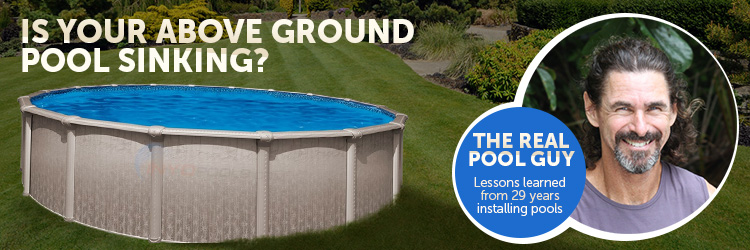
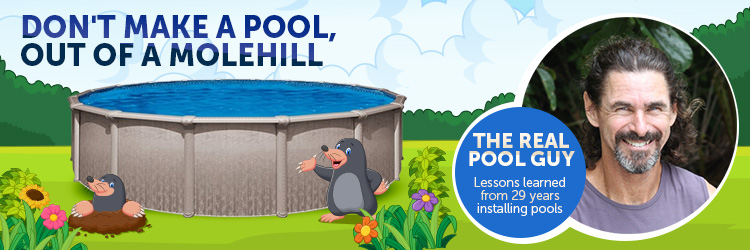
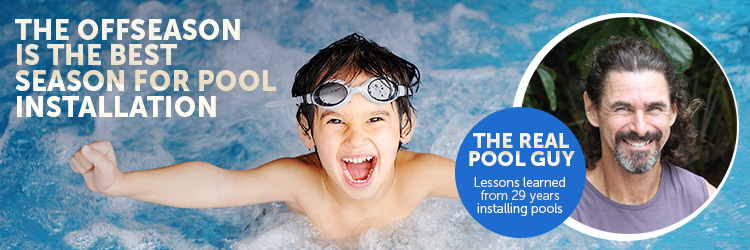
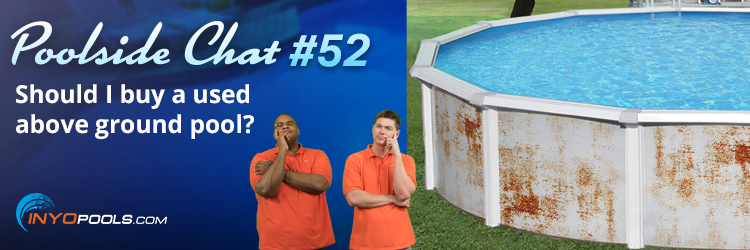
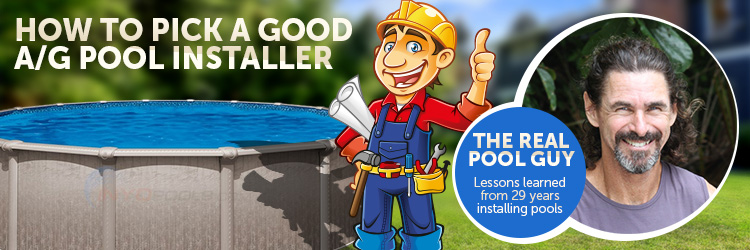






We’re going to completely sink an Intex 12’x24’×52″ pool in the ground, and our biggest concern is what to do with the filter and pump. We know it has to be below the water level, so can you suggest a good way to do that? We plan to deck around the pool, and figured we could build a box of sorts to house the filter and pump with an access panel built into the deck, but after finding this page, we would really like to know your thoughts/ suggestions on this issue. Thank you for your time and any info you can provide.
Building a box that won’t flood is fine. Think ahead about access as you’ll be servicing it often.
I’ve got an 11 year old daughter who is beating me to death to get a pool. I don’t want a traditional above ground pool and I doubt my HOA would let me have one even if I did. I also don’t want to drop 30 grand on an in-ground pool.
Here’s my idea, and somebody here please tell me if it’s nuts.
I’m considering renting a bobcat/backhoe thing and digging out a 13×25 hole (or whatever the total width with brackets is for a 12×24 above-ground pool), 4 or 5 feet deep. I’m then going to level the base, smooth out the sides, and create a shell on the four walls with cinder blocks which I’ll mortar together. I’m probably also going to do something with the “floor” of the hole. Blocks or Quickrete. Then I plan to drop a 12×24 Intex above ground pool into the hole.
I’m sure there will be some extra digging for a pump or something and I’ll have to measure out the exact dimensions WITH the brackets and the depth so the top top of the pool is level a few inches above the ground, but after I deck around it I think I’ll basically have an inground pool for a something on the order of a $3,000 total investment. No loan. Hooray.
Is this crazy? If not, should I dig a big hole for the pump as well or is there a pump I can buy that won’t have to be “buried”?
Thanks in advance for any help you can give me!
People sink above ground pools in the ground all the time so it’s not a nutty idea. And you can put the pump in a hole(that won’t flood) or buy an inground pump.
Dan, I regret I cant hire you as I live in NY… But, we are about to remove our 18′ round and get a 15’x30′ oval. I have been looking all over online and I cannot get a definitive answer for this. You said steel is best to sink, ok, but there are some people telling me I need a specific pool to sink. So , I guess my question is IS there a specific pool wall type or company I should buy from to sink it? Or can I get ANY steel wall pool and sink it? And, what was the best substrate to it on..sand correct? In NY here the ground is pretty solid, for foundation work its 4′ frost line.
You can sink any above ground pool into the ground but may have issues when you have to drain them for re-lining. They do make extruded aluminum sectioned walled above grounds that are specifically made for going in the ground. They cost considerably more though but will last much longer and give you less potential issues when draining. And yes, sand should work well for your earth.
Hey Dan,
We got an AquaSport 52, 24 ft. Round. We have dug our hole and our soil is Sandy loam all the way down.
What do you recommend for foundation? Can we simply use blocks for the sills?
hi Bob did you end up doing a pool.my daughter wants a pool as well did it work out doing this,
Hi Dan,
I’m in central Florida. The soil here is sandy . I want to install a 12x24x52in pool. Planning on digging out a 3 foot hole, so that 2 ft of the pool is above ground and building a deck around it. Can you recommend a pool?
Thanks
There is no mention of putting the pools on a concrete base and back filling with concrete near the posts. We know this adds to the cost but thought this would make it stronger and last longer. What are your thoughts on this and how would you adapt he installation
Thanks
It’s pretty expensive and I don’t like encasing any part of the pool in concrete. It makes it hard to replace or repair if needed.
I read that you can have up to about 1′ of sink in the pool to make it deeper in the center. Is this possible with an oval 15×30 considering the center posts have to hold the pressure?
You can do it in an oval too but most ovals have straps that run underneath so you can’t do it. Unless its a strapless model oval.
I’m so happy I found your blog! We’ve decided to buy a 36′ x 18′ pool which we will half sink and build deck around. Do you recommend steel? Can you refer a contractor?
Yes steel over aluminum. Although it’ll be hard to find an 36″ aluminum walled pool. I don’t know where you live so no.
Have a 35 yr old Ester Williams 4.5 deep 14’x28′ 8 sided in-ground pool. We know it is nearing the end of its life. We have by passed the main drain, skimmer line and one return line. We replumbed everything including the solar mats through the filter and we swam over 100 days in crystal clear water. We live in Buffalo, NY and the cost of a new pool with replacing the old one is 35 to 50 grand. That is out of the question. Getting rid of it all together is between 10 and 17 grand. My wife and I still like the idea of a pool but have limited funds so the idea of sinking a pool in the shell sounds intriguing. What would you recommend size wise and should any local pool contractor know how to do this?
I’m not sure what you mean by “sinking a pool in the shell”. If I can play Swami here and guess that what you mean is to place maybe a 12×24 oval above ground pool within your existing ancient pool, then I say yes it can be done. It won’t be easy and you’ll have to deck to the smaller pool but it would be considerably cheaper than your alternatives.
nice article! we partially buried our above ground pool in 1995 and it is still there. we did wrap the pool wall in plastic first, then backfilled by hand once the pool was filled with water. i recently dug out a section of the wall and was surprised to find virtually no rust. just a few surface rust areas. i think the only problem was the quality of the plastic i used. i should have used an old pool liner or similar to protect the wall.
I am going to build a deck all the way around my pool after I bury it. Do I have to back fill?
You don’t have to backfill but the earth will eventually naturally fill in the gap. So what earth will move to make that happen? Make sure your deck isn’t supported by the earth that will move into the backfill gap. I hope this makes sense. I didn’t know any other way to explain it.
That’s a great thought because I am doing the same thing. I also appreciate the advice of sprinkling in cement with your back fill dirt. Makes great sense.
One thing not mentioned in sinking your pool is drain tile covered in P- gravel. I just in the past week dug a hole and put a pool in at my house . I am now in the process of back filling it with drain tile and P gravel (already filled it with water). And then I’m going to put clean dirt the rest of the way up (pulling out substantial rocks as I go). Is there any need to spray it or put any kind of tar on the walls the same as you put on a basement foundation wall?
Drain tile and gravel wasn’t mentioned because it is not needed. I mean, it’s cool that you did it to your pool and all but…it’s not needed. If the pool is in the ground, then where is the drain tile going to lead the water. And what water are we talking about? Ground water? It’s already in the ground. You could coat the outside of the pool if you want but I don’t think it’s worth the time expense. I would though sprinkle in some cement with your backfill earth. You’ll need that earth to stay in place when it comes time to change the liner and you have to drain the pool.
FYI never put tar or foundation paint on coated steel. It will eat through the protective layer on the steel which will provide far more longevity then tar or foundation paint.. This is a pool not a foundation.
I have a company installed a 15′ x 30′ oval above ground pool for me and dropped it halfway into the ground. Unfortunately, they’ve done a lacking job. When it first was filled up with water, it was totally even on every side, however now (a few days later) it’s 1.75″ deeper on one end the other. The bigger problem is that deeper end is NOT on the skimmer side, meaning the pool has to be filled very close to full capacity for the water level to reach halfway to the skimmer on the shallower side. My question is, is there a way to re-level my pool, even if it’s halfway in the ground? I know that the water has to be drained and I’m not really worrying about the pool caving it cause it has a really strong steel wall. It may be a bigger issue to dig the dirt out around it again, so there is room for the work. I’m in Orlando, Central Florida, by the way. Thank you!
Since I am in Orlando, I’m curious as to who built it. This would be a major fix. With It being newly in the ground, the earth around to outside of the pool will probably have to be dug out BEFORE you drain the pool.
Dan, I’m in Orlando and looking to have a pool installed soon. Is that something you could assist me with? If so, please feel free to email me at cstires@outlook.com
Chris, for inquiring about an install, go to my site: centralfloridaabovegroundpools.com for some info and you can contact me from there. Thanks.
I live in South Florida and I installed an above ground pool in my house. I wanted to sink the pool in ground with a retainer wall if possible and wanted to know the cost of doing this. I also wanted a good reputable company that can do it for me. Thanks for your help.
If you are in South Florida, I can’t help you as you are too far from me. Please read my article on how to find an above ground pool installer and cross you fingers AND you toes.
I have the same question as Len Kirkland, Can I concave the center to make it deeper when they do my install ,if so how much of a dip can they go down? Also how much cheaper will it be to do an above the ground deeper pool then an Inground pool (rough estimate)?
Up to one foot for a standard liner. Expandable liners can go deeper. And tens of thousands.
Our pool is about half way in the ground and we don’t know what to fill the gap around the sides with. We were worried about backfilling it with dirt due to the pressure it would put on the pool. What do you recommend? Sand? Pea gravel?
The dirt will be fine as far as pressure goes as the pool is filled with water and is creating quite a bit of outward pressure. I wouldn’t put sand or gravel though as you want something that will stay in place when it comes time to drain the pool to re-line it.
would u be able to bury a aurora pool ?
Local and online dealers have a tendency of renaming pools. There are a few different Auroras out there made by different manufacturers, with different component materials. What is your pool made out of?
Don’t know. Who makes this “Aurora” pool? To me, this is just a retailer’s name for what could be anything. Check with the store that came up with the name. Or maybe look to the sky. North.
I know every scenario is different but I’m wondering what type of price ballpark would it be to do this? If an inground pool is $30-$50k or more, how much cheaper is this? We already have an above ground pool from the previous owners of our house, it’s currently about 2/3 sunk inground as it was installed into a hill. We want to dig it up and relocate it to our side yard and still then sink it again. Any idea on ballpark price range for this type of job?
Depends on the size and shape of the pool. Since I have no idea what size, the ballpark range is $700 to $4000. Also, you’ll need a new liner. Next time, tell me the shape and size of the pool. I’ll then be able to give you some useful info.
Can I concave the center to make it deeper when I do my install ,if so how much of a dip can I go down
Yes. A standard liner should easily be able to accommodate up to a one foot deep center.
We live in central Florida and would like to install a galvanized above ground pool partially in ground. Our neighbors have a above ground fully installed above ground they have a problem with areas in the bottom where there are dips from the ground settling. Would we end up with that same issue due to the type of ground here? TYIA
The ground doesn’t really settle that much here so chances are your neighbor’s pool has dips for other reasons. Regardless, you would get the same issue maybe even more so with the pool on top of the earth as there is a greater chance higher up for moles or ants.
Thanks for the great tips. Just wanted to mention, I think tip IV should say “Above ground pool pumps have to stay BELOW the waterline”. I think it’s just a typo.
Good catch, thank you for the edit.
Is there a specific type of pool that’s better suited for sinking, such as steel vs resin or aluminum?
Steel because it is less flimsy.
What about corrosion
Do you have anyone you would recommend in putting above ground pools all the way in the ground.
I do not and don’t ever recommend doing that.
The home I bought had that situation. The above ground pool was only 1′ out of the ground. This winter we had 3 days of terrible rains and the area around the pool acted like a bucket, filling up with water, causing the winterized pool to cave in, in several spots.
Might I also add, it had the original liner, because the installer used pea gravel to backfill. If the water was removed, the weight of the gravel would’ve caved it in the same way.
FYI, insurance DOES NOT cover a collapse on such an installation…
Here’s my question I’m buying home that has an above-ground 24-foot pool but I want to sync it halfway down what do I need to do do I have to call a company to pump out the water or what and how is it done or can it be done
It probably can be done but I’m not sure as I don’t know anything about your yard or where you are. You’ll definitely want to start with talking to some local above ground pool installers if you have some in your area. If you are going to re-use the same pool that is there, keep in mind that you’ll be needing a new liner for it. And you probably won’t need someone to pump the water out. Since you’ll be using a new liner for the re-install, you can poke some holes in the bottom of the pool and let the water slowing drain into the earth.
doughboy pool installation says to fully sink pool and backfill with slurry type cement not soil.I want to be able to empty the pool at beginning of every season .Is this possible will liner slip.how do i stop pool walls caving in.another thought i had was to go 2 ft down.Then have walls a foot back maybe a bit more.Then bulid it up and pave up to the pool.is this possible would rather not have decking as do not want the decking if possible
You should not empty the pool because without water, the liner may shrink to the point that it is no good. If you do what Doughboy says and do it right, your pool won’t cave in. I still only recommend going down a maximum of 2.5 feet.
thanks for reply
also any thoughts on roots in ground being a problem
check to make sure you’re not voiding your warranty by sinking your brand of pool!
What if only one side of the pool is in ground as in my case because of where I had to put the pool. Can that cuase issues with wall caving or deteriorating quicker.
I’m putting my pool into bank. So around 1/3 of it will be ground level. Any comments on that thanks.
We sink our pool now the sand is making the liner to have humps at the bottom what can we do the liner is not smooth
Thank you
Nyoka Bryant
We’ve had our sunken pool for a couple months now, I noticed within the last week the bottom is getting very uneven. As if the sand is shifting or sinking more, moreso on the sides at the bottom where the walls start. Has anyone had these issues that you know of? Also where the braces/poles, the metal pcs on the side is, between them, the wall is as it’s bowed inward. Our pool was full for at least a week before the backfill started. We did the backfill ourselves because of the weather. We were working around all the spring rain we got here in Texas this year. Do you know what would cause this? It’s as if the poles are too close together. Thanks for any help or advice. Lora Rand
From Dan:
The earth is dynamic for sure but it doesn’t move that much in such a small time frame. More than likely, you are either noticing the unevenness of your pool bottom for the first time OR you did not pack earth under your pressure plates well enough and the voids you left are filling in. I wouldn’t worry about it.
As far as you pool sides go, this probably tells me that your bottom hasn’t moved because it is almost impossible for the sides to move inward after the pool is filled with water. My guess is that you are noticing that the straight sides of your oval are not straight but scalloped. This is probably just the design of your oval. Even if you have really messed up the buttress assembly, the wall/buttresses wouldn’t be able to move as they are buried on the outside and full of water on the inside. I see this as a perception thing unless you built your pool on a fault line:)
Dan, Thank you for your comments. One item I was hoping you would cover is the installation of a floor drain or drains. If desired, does the drain have to be placed in a concrete or vermiculite base? What do you recommend?
Thanks,
Steve
Hello Steven,
Here is the answer from Dan:
“Hi Steve. Look for my blog post on main drains. Main drains do not need to have a base. I do use a 6″x6″ block under the ones I install though.”